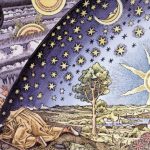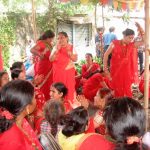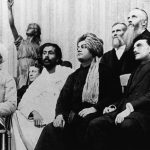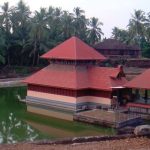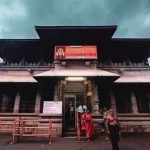Sri Ramakrishna Paramahamsa is one of the most well-known saints of modern India. His name and teachings live on in the institution founded in his name by his disciple Swami Vivekananda; The Ramakrishna Mission. Sri Ramakrishna Paramahamsa’s message was that there is only one God and that all beings are divine. He did not discriminate between religions, caste or creed.
Childhood
Sri Ramakrishna Paramahamsa was born in a Brahmin family in 1836 in a small town near Calcutta. The family was poor and his parents were very religious. His father Ram Kumar had a vision of Gadadhara (Vishnu) telling him that he would be born to him as a son. Hence, Sri Ramakrishna Paramahansa was named Gadadhar. As a child, he was a talented actor, storyteller and artist.
Ramakrishna Paramahansa did not show interest in school or day to day practical activities. However, he liked the subjects of Sanskrit and Mathematics. Even at a young age, the service of holy men attracted him. At the age of six, he went into ecstasy when watching cranes flying against black clouds. He often had such spells of ecstasy. Once while enacting a school play in the role of Lord Shiva he lost all awareness of the external world. He would experience episodes of loss of consciousness and would often go into spiritual reveries.
Vision Of The Goddess Kali
After the death of Gadadhara’s father, his elder brother became the priest at the Dakshineshwar temple. Later Gadadhara took the same position when his brother retired. In 1866, he was the priest of a new Goddess Kali temple near Calcutta. This temple was built by Rani Rashmoni, Queen of Janbazar, Calcutta, on the banks of the Ganges. Gadadhara became a great devotee of the Goddess and spent time meditating on her and giving her offerings.
Ramakrishna Paramahansa meditated on the Goddess in a sacred grove of five trees on the temple grounds. His greatest wish was to have a vision of her. When his wish was not fulfilled, he became frustrated. He threatened to take his life with the dagger that was normally in the Goddess’s hand. When he did this, the Goddess appeared to him as an ocean of light. Instead of the physical temple and structures that were around him, he only saw an infinite ocean of light. The billows of the ocean rushed towards him and there was a great noise. It was as if the waves were rushing at him to swallow him and he fell unconscious. He felt a new divine bliss inside him and felt the presence of the Goddess with him.
Marriage
Despite the great bliss that Sri Ramakrishna Paramahansa experienced, his family saw his behaviour as extremely erratic. As his behaviour ‘worsened’, his employer and family became increasingly worried. His family under the misapprehension that he was mentally unstable because of celibacy found him a bride, Saradamoni Mukhopadhyay.
Finding Guidance
A holy woman Bhairavi Brahmani contradicted the fears of Sri Ramakrishna Paramahansa’s family. She told them that he was not mad. He was actually filled with “spiritual madness” that was similar to many other saints. She compared his madness to the divine madness of the fifteenth-century Bengali saint Chaitanya. Thereafter, people gave Sri Ramakrishna Paramahamsa more respect despite his unusual behaviour. Bhairavi Brahmani then stayed with the young Ramakrishna and taught him about meditation techniques. Ramakrishna then came under the tutelage of a Yogin by the name of Totapuri. From him, he learned the non-dualist Vedanta philosophy. He then became a renunciant. He started experiencing deep trances where his soul was fully absorbed into the ocean of consciousness. This is called Nirbikalpa Samadhi.
Disciples started following Sri Ramakrishna Paramahansa and he taught them. His disciples recorded his talks in two books. We find references to many or Ramakrsihna Paramahansa’s teachings in these documents.
Teachings
Ramakrishna Paramahansa told his disciples that God could be both formless and with a form. The way in which each devotee perceived the Supreme was individual and unique. He always asked his disciple what their vision or concept of God was. Ramakrishna Paramahansa asked if they saw God as one with qualities or one who was beyond qualities. He then guided the student based on his own individual perception of the divine.
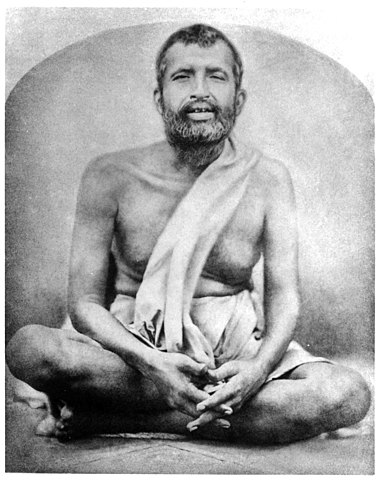
Sri Ramakrishna Paramahansa
Universalist Non-Dual Approach
Ramakrishna Paramahamsa accepted different approaches to God. He respected the validity of all the different religions as different paths to the divine. This is the tradition of the universalist approach to religion. This universalist approach was very attractive to people from across all walks of life in Indian society. His message of all religions being different paths to the same destination was more acceptable to the Indian mind than perhaps in a Western culture where religions tend to be more exclusive.

Sri Ramakrishna Paramahansa
God As A Mother
Ramakrishna Paramahansa used the allegory of God as a mother cooking fish for her children to explain this approach. He sais that a mother knows the likes, needs, temperaments and digestive ability of each of her children. Hence, she cooks each fish differently for each of her children according to their individual needs.
Ramakrishna Paramahansa explained that each religion was likened to the individual fish that is specially prepared for the mother. This concept appeals to the Indian mind as the mother is seen as a self-sacrificing person who puts the needs of her children above her own. With God being the mother of the universe as well as each individual soul, religion has been tailored for each person depending on their personal tastes and needs. This was particularly appealing to the upper classes who tend to take the Vendantist or philosophical approach to the concept of the divine.
The existence of God as a non-dual formless essence is easily understood by those with a philosophical bent of mind. When his students showed an interest in Yoga and other spiritual practices he taught them what he learned from his own Guru Totapuri. It was a non-dual meditation practice that sought to attain Samadhi.
Bhakti Approach
Although Ramakrishna Paramahansa was a believer in the universal non-dual approach to God he was also a great devotee of Goddess Kali. His message included the people who approached God through devotion and worship to deities. Goddess Kali is seen as a deity who has a very fierce and destructive side but is also a benevolent mother to her children. Ramakrishna Paramahansa worshipped her as the protective and loving deity. This appealed to the people who followed this approach of Bhakti to God as they saw him also perform his worship and duties while also singing great praise of his chosen deity. So, they also followed his example by maintaining their practices of devotion to their chosen deities.
Ramakrishna Paramahansa believed that a devotee who was very devoted and sincere in the worship of their chosen deity could be blessed with a dream or vision of their chosen form of God. He was always respectful and welcomed visitors who were greatly devoted to different deities. Ramakrishna Paramahansa also gave them guidance on how to proceed along their individual spiritual path. He also spoke highly of the great saints of the past who were worshippers of deities different from his own chosen path.
One Truth
Since Ramakrishna Paramahansa practised the rituals of different religions and all of them brought them to the same desired end, he was an example of his message. He illustrated by his own life that there is one truth and that all religions were the different means to the very same truth. As Indian society has many people who follow their own individualistic worship of their own chosen deities, this approach resonated with them.
Householder And Monk
Ramakrishna Paramahansa’s wife Saradamoni Mukhopadhyay aka Sarada Devi joined him at Dakshineshwar when she was 18 years old. He instructed her in household duties as well as spirituality. A few months after she had arrived there, he made arrangements for the worship of the Goddess Kali. But, instead of the deity he seated his wife as the Goddess and worshipped her. This is the Shorashi Pooja or the Pooja of the adoration of woman. Both the worshipper and the worshipped elevated to a transcendental plane and united in spirituality.
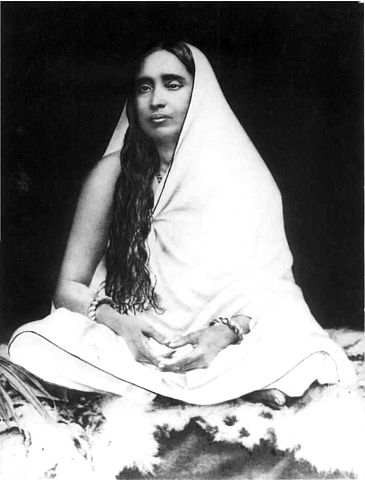
Saradamoni Mukhopadhyay – Sarada Devi
Ramakrishna Paramahansa surrendered to his wife as the living embodiment of the Goddess. They lived together not as man and wife but as spiritual companions and Ramakrishna Paramahansa kept his spiritual vows. He lived his life as a householder and also a monk without giving up his vows or his spiritual path. He called his wife the Holy Mother as also did his disciples.
Samadhi
Ramakrishna Paramahansa developed throat cancer in 1885. The finest doctors treated him and his wife and disciples cared for him. He then attained Samadhi in 1886.
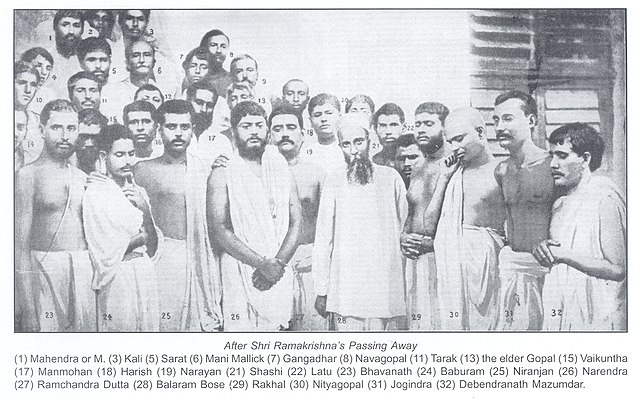
Ramakrishna Paramahansa ‘s Disciples At His Funeral
Swami Vivekananda
Swami Vivekananda was a disciple of Ramakrishna Paramahansa. He took the universalist message and combined it with his strong feelings of patriotism. Swami Vivekananda addressed the World Parliament of Religions at Chicago in 1893 and made a huge impression on his audience. He made the world at large understand that even though India was financially in a poorer state, the country was rich in spirituality as well as philosophy. Swami Vivekananda took Ramakrishna Paramahansa’s message to the world. He set up an institution in the name of his Guru; The Ramakrishna Mission.
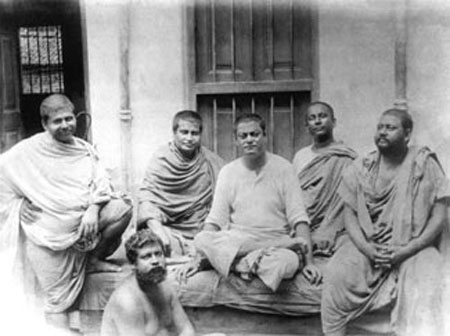
Ramakrishna Paramahansa ‘s Disciples




